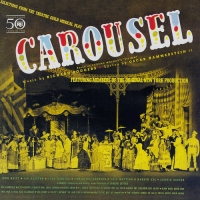
From Broadway To 52nd Street
The Majestic Theatre opened the curtain for Carousel for the first time on April 19, 1945. With music composed by Richard Rodgers and Oscar Hammerstein, the musical ran for eight hundred and ninety performances. John Raitt and Jan Clayton had the title roles in this play adapted from the famous Molnar story of Liliom, from which came two songs that would endear themselves for years as jazz standards – What’s The Use Of Won’drin’ and If I Loved You.
The Story: Billy Bigelow, a shy New England carnival barker falls in love with Julie Jordan. Eventually winning Julie’s heart, he later discovers she is pregnant. Jobless, Billy decides he must provide for his son, or daughter, he agrees to join his criminal friend Jigger Craig in a robbery to earn extra money. The plan misfires and Billy kills himself rather than being caught. Before a heavenly judge he pleads for another chance to return to earth to earn his redemption and see his daughter. When his daughter refuses his gift of a star he has stolen from the sky, he slaps her and returns to purgatory. The widowed Julie and child are left to continue to live starkly. The story is set in Maine where majestic backdrops add emotional emphasis.
Jazz History: It was known simply as The Street and as historian Arnold Shaw stated in his book 52nd Street, “If you flagged a taxi in NYC and asked to be taken to The Street, you would be driven, without giving a number or an avenue, to Fifty-Second Street between Fifth and Sixth Avenues” By the late 1940s, as the jazz clubs turned into strip joints, many bemoaned the death of The Street. They considered this era to be the block’s decline.
In 1948, Time magazine decried the change from jazz to bump-n-grind: “where nightclubs in sorry brownstones crowd each other like bums on a breadline”, an era was all but over. Swing was still there, but it was more hips than horns. Barrelhouse had declined and burlesque was back. There was little jazz left on 52nd Street and even the customers had changed. There were fewer crew haircuts, pipes and sports jackets and more bald spots, cigars and paunches.
Sponsored By
www.whatissuitetabu.com
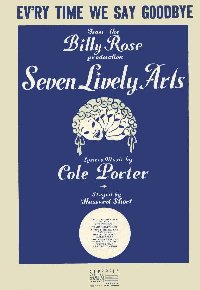
From Broadway To 52nd Street
Seven Lively Arts opened at the Ziegfeld Theatre on December 7, 1944 and the curtain rose for 183 performances. Billy Rose produced the show, hiring Cole Porter to compose the music that spawned the jazz standard Ev’ry Time We Say Goodbye.
The Story: The musical featured eleven sketches such as Local Boy Makes Good, Pas de Deux and Heaven On Angel Street. The short-list of actors included Beatrice Lillie, Bert Lahr, Alicia Markova and Doc Rockwell. They are augmented with the talents of jazz notables Teddy Wilson, Red Norvo and Benny Goodman.
Broadway History: By the Mid 40s most theaters on Broadway that had been a good investment and a symbol of vivacity and mirth from the turn of the century were now considered uneconomical. Increasing real estate values was forcing the theaters into obsolescence, turning them into film house to accommodate the takeover by movies. A second threat during this period in the competition for audience was the emergence of television, which was providing free entertainment. The result of these two industries was a shocking 80% unemployment rate for Broadway actors in 1948, and for the first time in its history, Broadway had to call a general emergency meeting for all unions and theater people.
Sponsored By
www.whatissuitetabu.com
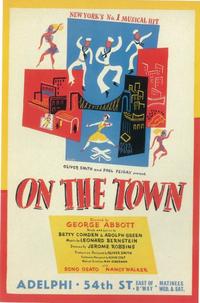
From Broadway To 52nd Street
On The Town opened at the Adelphi Theatre on December 28, 1944 and ran for 463 performances. Leonard Bernstein composed the music and Betty Comden and Adolph Green wrote the lyrics. The musical starred Betty Comden, Nancy Walker, Adolph Green, John Battles, S. Ono Osata and Chris Alexander.
The Story: Three sailors – romantic Gaby, down-to-earth Chip and clownish Ozzie are on shore leave in New York City. During a subway ride, Gaby falls in love with a picture of Miss Turnstiles. This event leads the guys on an adventure to find her. Roaming around the city as far as the museum of Natural History and Coney Island, the other two also find love. Nancy Walker plays the cab driver. From this play New York, New York and Some Other Time became jazz standards.
Jazz History: American involvement in World War II, which began on December 11th, 1941 marked a decline in the importance of big bands in popular music. Many musicians were sent to fight in the war, and those who remained were restricted by high taxes on gasoline. By the time the ban on recording was lifted, big bands had practically been forgotten, or had begun to be thought of as peripheral in relation to vocal stars such as Frank Sinatra.
The fall of the Big Band began on August 1, 1942 when the American Federation of Musicians initiated a strike against all major recording companies because of a disagreement over royalty payments. No union musician could record. The effects of the strike include the shrouding of the developments of bebop in mystery. There are few documents that can provide evidence of what the early forms of the music sounded like.
Sponsored By
www.whatissuitetabu.com
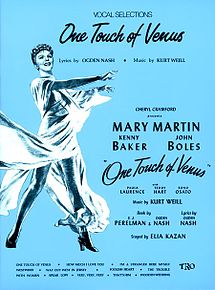
From Broadway To 52nd Street
One Touch Of Venus hit the stage of the Imperial Theatre on October 7, 1943. Kurt Weill composed the music, with lyrics by Ogden Nash. The musical ran for 567 performances and starred John Boles, Kenny Baker, Ruth Bond and Mary Martin. One song, Speak Low, distinguished itself from the pack to become a jazz standard.
The Story: When Whitlaw Savory tells his barber, Rodney Hatch, that his statue of Venus is the most beautiful woman in the world, Hatch disagrees. After all, he is engaged to the most beautiful woman, Gloria. To prove his point, he places Gloria’s engagement ring on the marble, which promptly comes to life. The escapades of Venus and Hatch turn Manhattan upside down, with Savory, Gloria and her mother in pursuit. The fling destroys the Hatch/Gloria romance, so Hatch is disconsolate when Venus returns to stone. But as he is about to walk away, a young girl appears who is the image of Venus and Hatch is certain he has an engagement ring to fit her finger.
Broadway History: During the 1940s, Broadway began to lose its originality and drive. New dramatists were less numerous and Broadway began to face competition from television and movies. Some theaters were pulled down, and now theater no longer dominated Broadway.In the forties, 42nd Street between Seventh and Eighth Avenues, the street most associated with Times Square, began to look less and less like a theater district. The theater business was declining all over the city to the point where there were not enough productions to support the available playhouses. In comparison to the 264 productions in 1927-1928, the number dropped to 187 in 1930-1931, and only 72 in 1940-1941. Times Square had degenerated into a kind of carnival and sex bazaar. The Republic Theater, which was built by Oscar Hammerstein in 1900, became Billy Minsky’s burlesque house. Theaters all over the area were being torn down or turned into slums.
Sponsored By
www.whatissuitetabu.com
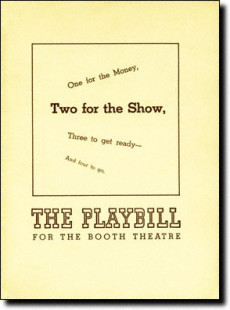
From Broadway To 52nd Street
Two For The Show opened on Broadway at the Booth Theatre on February 8, 1940 and after 124 performances the curtain came down for its final descent on May 25, 1940. Directed by John Murray Anderson with the sketches directed by Joshua Logan and musical staging by Robert Alton, the original cast included later Hollywood notables as Eve Arden, Alfred Drake, Betty Hutton and Keenan Wynn.
The Story: This was a revue with several sketches being performed such as “The Age Of Innocence” and “Cookery” written by Richard Hadyn. There were two other revues in this series, all conceived and directed by John Murray Anderson: One for the Money (February 4, 1939-May 27, 1939), and Three to Make Ready (March 7, 1946-December 14, 1946). The most notable song introduced in the show was “How High The Moon” which subsequently has been recorded by many jazz artists, becoming a well-known standard
Jazz History: Bebop or bop is a style of jazz characterized by fast tempo, instrumental virtuosity and improvisation based on the combination of harmonious structure and melody. It was developed in the early to mid-1940s and first surfaced in musicians’ argot sometime in the first two years of American involvement in WWII.
The origins of the term “bebop” has been debated by numerous authorities and researchers usually stated to derive from nonsense syllables or vocables used in scat singing, and is supposed to have been first attested in 1928. However, some researchers speculate that it was a term used by Charlie Christian because it sounded like something he hummed along with his playing.Yet, Dizzy Gillespie’s version of the story relates that the audiences coined the name after hearing him scat the then-nameless tunes to his players and the press ultimately picked it up, using it as an official term: “People, when they’d wanna ask for those numbers and didn’t know the name, would ask for bebop.”
Sponsored By
www.whatissuitetabu.com


